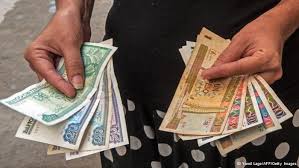The “Dark Triangle” of Social Equity in Cuba
and the Opinions of the Left
Dmitri Prieto

HAVANA TIMES — Recent announcements about Cuba’s imminent monetary unification do not afford us much information on the changes we can expect to see over time.
Talk about this reform measure has been going on for some time now, and the “Press Note” did not exactly explain the issue or offer anything resembling a chronogram or a sense of the concrete measures that will begin to be applied soon.
Rather, it aims at making the government’s decision to gradually re-establish a single currency in the country visible, against the more pessimistic opinions about this that have been circulating of late.
I find the comments that have been published in this connection very interesting. These go from detailed explanations on how the Cuban Convertible Peso (CUC) – Cuban Peso (CUP) exchange rate in different business contexts has changed over time to the psychological effects of the transition from a two-currency to a single-currency monetary system.
In a previous post, I commented that what the Cuban population needs today is not a specific currency but purchasing power, expressed numerically in any currency.
The official Press Note clarifies three points of “economic” importance:
– The measure aims at maintaining the Cuban Peso (“domestic currency”, “working class peso” or CUP), not the CUC or a hypothetical new, third currency (years ago, it was speculated Cuba’s economy would adopt the Sucre or a new currency, which was tentatively to be called the Mambi).
– Apparently, the current exchange rate of 25 CUP / 1 CUC will be maintained.
– Also (and this is very important), the government guarantees (at least in its official discourse) that bank deposits in the two currencies and foreign hard currencies will not be affected (against rumors and a number of past experiences with “currency changes”).
The “psychological” message behind this – which is just as clear as the financial one – is that we must forget, once and for all, of ever going back to the parity between the Cuban Peso and the US dollar…and that those areas of the country’s economy where such a fiction (and the non-mathematical category known as the “total currency”) still exists will gradually have to adjust to hard, current reality.
Now, we have to place this within the context of what I call the “dark triangle” of Cuba’s socio-economic reality, or, more specifically, of Cuba’s current “social question”, where the word “social” refers to social justice or equity.
To be continued…






Check your facts. Australia has no such agreement with China in place. Nonetheless, the recent shenanigans in Washington have caused rumblings around the world regarding using the USD as the reserve currency of the world. Undoing this standard would indeed have tectonic implications. However, not only for the US but for the entire world, including Cuba. The Happy Planet Index is goofy and not to taken too seriously. By design, developed countries with more economic activity and a greater energy footprint rank lower than underdeveloped countries. Happiness is largely defined by measures which favor non-consumer-based societies. While more iPhone 5s does not necessarily make a society happier, less smartphones usually means a society is lacking something else very important to well-being…money! Of course, with a name like ‘moonquake’, you will likely disagree. 😉
This lacks many other aspects to get a full picture. Lets say, you can start asking yourself why Australia made agreement with China not to use USD in their trade anymore. I would worry more about dollar collapse in near future, because consequences will be of tectonic proportions. Check what amounts of dollars are returning to US these days from all over the world, and also why, and what are the predictions about it. When talking about quality of life, check Happy Planet Index. It evaluates quality of life, taking into account ecological footprint and 2 rules: Not to steal from other nations, and not to steal from future generations. Cuba is there among top 20, USA above position 100. And that is just beginning. Also, in order to get real picture, good way is to put emotions and personal interests aside.
There is no economic reason to hope for a 1 to 1 parity between the CUP and the USD. Exchange rates are the concern of tourists and currency exchange traders. Cubans should be more concerned about what a specified quantity of CUP will purchase. Known as “Purchasing Power” (or PP), this quantitative measure is a better barometer of quality of life. Cubans live as well as they do because of an estimated $6 billion in remittances and $6 billion in Venezuelan subsidies as measured against a $60 billion national budget. Without these supports and a host of other foreign aid, Cuba would grind to a halt. Unifying the currencies will make national accounting simpler and will better reveal the differential between Cuban elites and the rest of the country. It will do little to improve the quality of life for most Cubans. Until productivity and exports increase and salaries rise, the disastrous effects of the last 54 years of Hurricane Castro will constrain Cuba to remain a poor and backward economy.